- Blog
- Certificado de Inspección Técnica de Vehículos en la UE - Lo que deben saber los concesionarios de la UE
Certificado de Inspección Técnica de Vehículos en la UE - Lo que deben saber los concesionarios de la UE
Cumple con las normas y mantén la seguridad de tus vehículos con nuestra sencilla guía sobre certificados de inspección técnica. Descubre qué es un RWC y cuándo lo necesitan los comerciales de automóviles.
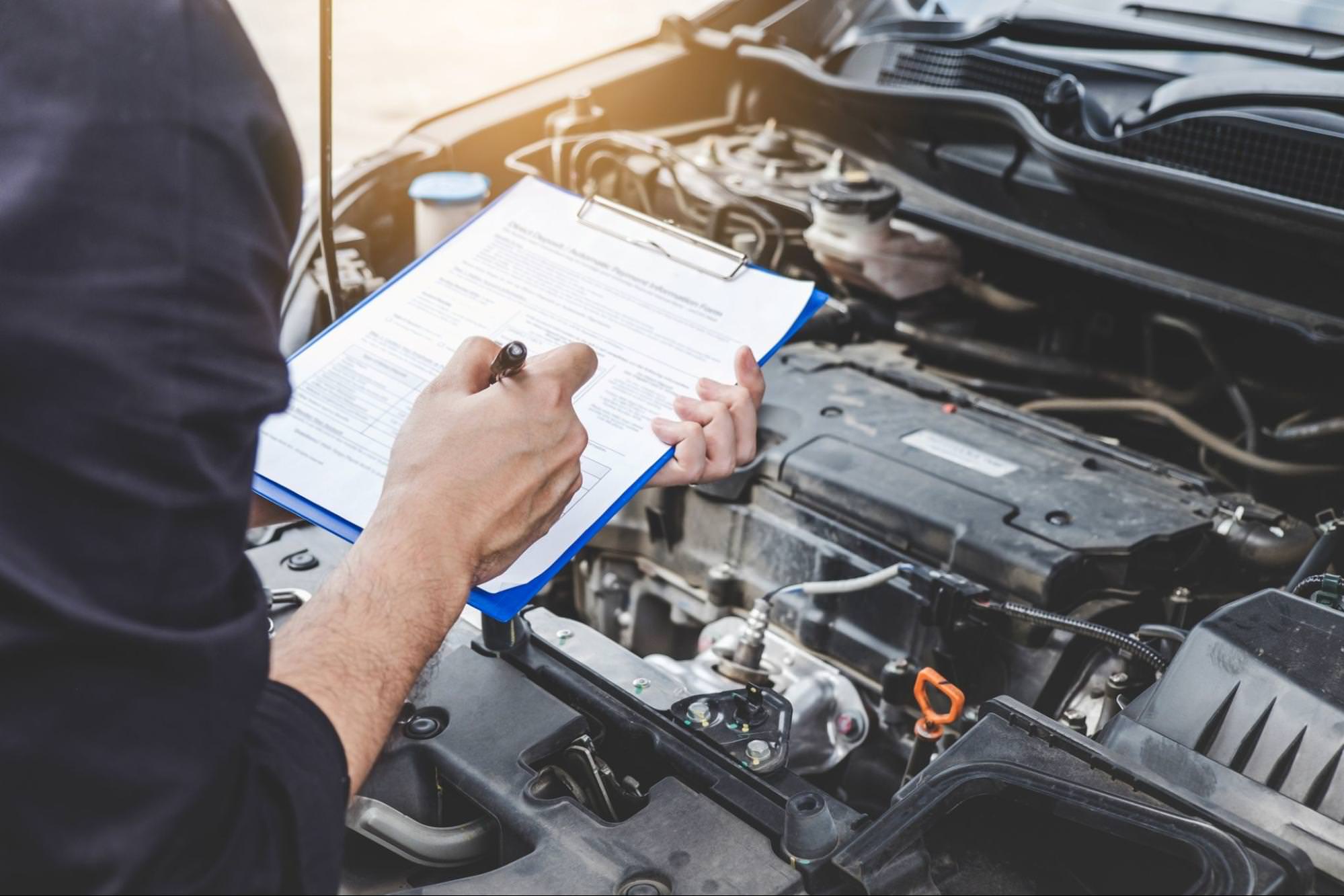
Varias normas y reglamentos europeos mantienen a los vehículos peligrosos fuera de las carreteras.
Una de estas medidas es el Certificado de Inspección Técnica de Vehículos, un documento que acredita que un vehículo cumple con los estándares de seguridad y medioambientales, permitiéndole circular por la vía pública.
Por lo tanto, si te dedicas al comercio de automóviles usados en la UE, es fundamental comprender los diferentes Certificados de Inspección Técnica y las normas que los rodean. De esta manera, tú y tus compradores tendréis garantizado el cumplimiento legal para evitar posibles problemas al registrar los vehículos.
¿Qué es la Directiva de Inspección Técnica de la UE?
El certificado de Inspección Técnica (RWC) no está estandarizado en toda la UE; Cada miembro de la UE tiene su propia versión de RWC. En España, por ejemplo, se trata de la archiconocida Inspección Técnica de Vehículos (ITV).
Sin embargo, cada versión se basa en la Directiva 2014/45/UE, conocida como Directiva de Seguridad Vial de la UE.
Esta directiva establece los estándares mínimos para las inspecciones de vehículos en todos los estados miembros de la UE. Básicamente, su objetivo es reducir los accidentes de tráfico y la contaminación, garantizando que los vehículos sean revisados y mantenidos periódicamente.
A continuación tienes una descripción general de algunas áreas clave cubiertas por la Directiva:
- Categoría del vehículo
- Intervalos de inspección
- Exenciones
- Clasificación de defectos
- Prevención del fraude
El texto completo está disponible en EUR-Lex . Pero si prefieres una versión simplificada de la Directiva de Inspección Técnica de la UE sin toda la jerga legal, este resumen completo de la legislación creado por el observador de la UE te resultará muy útil.
¿Qué significa el "permiso de circulación" en la UE?
Descubrirás que a veces también se hace referencia al RWC o ITV como el permiso de circulación. Pero, ¿qué normas se deben cumplir para que un vehículo tenga permiso de circulación?
La respuesta depende de su categoría, en un listado que incluye vehículos como tractores rápidos, motocicletas, o incluso remolques pesados.
Pero para simplificar las cosas, nos centraremos en la categoría de vehículos M1 (automóviles de pasajeros diseñados para transportar hasta ocho pasajeros), ya que es con la que se suelen enfrentar a diario la mayoría de los concesionarios de automóviles.
Así, según la Directiva de Inspección Técnica de la UE, un vehículo se considera apto para circular si cumple varios criterios durante las inspecciones. Estos criterios incluyen:
|
Criterio |
Breve descripción |
|
Equipo de frenado |
El sistema de frenado del vehículo debe ser eficaz y fiable. |
|
Dirección |
El mecanismo de dirección debe ser preciso y seguro. |
|
Visibilidad |
Incluye la funcionalidad del parabrisas, los espejos y el limpiaparabrisas. |
|
Lámparas, reflectores, equipos eléctricos. |
Todas las luces, indicadores y componentes eléctricos deben estar operativos. |
|
Ejes, ruedas, neumáticos, suspensión. |
Estos componentes deben estar en buenas condiciones y cumplir con los estándares de seguridad. |
|
Chasis y accesorios para chasis. |
El bastidor del vehículo y las piezas adjuntas deben estar seguros y libres de corrosión o daños importantes. |
|
Otros accesorios |
Incluye cinturones de seguridad, bocinas y otros equipos obligatorios. |
|
Contaminación |
El vehículo no debe emitir ruido excesivo ni contaminantes, garantizando que cumple con las normas medioambientales. |
La directiva también define cómo se debe probar cada criterio, y enumera las razones de un resultado desfavorable o negativo.
En definitiva, un vehículo está apto para circular si supera estas inspecciones en centros de pruebas autorizados.
¿Cuándo debes pasar la Inspección Técnica del Vehículo?
Todos los vehículos de la UE deben someterse a inspecciones técnicas a intervalos regulares. Por ejemplo, los turismos y los vehículos comerciales ligeros (categorías M1 y N1) en la mayoría de los países deben someterse a pruebas cuatro años después de su primera matriculación y, posteriormente, cada dos años.
Puedes consultar la frecuencia de inspección para otras categorías en la Directiva 2014/45.
En algunos casos, se necesitan inspecciones adicionales para todas las categorías de vehículos, y estos casos son:
- Después de un accidente
- Cuando cambia el titular del certificado de registro
- Al alcanzar los 160.000 km
- En casos que afecten gravemente a la seguridad vial
Sin embargo, el dato más importante para los comerciales de automóviles es que deben pasar inspecciones técnicas cuando importen automóviles de otros países a su país.
Incluso si el automóvil tiene un Certificado de Inspección Técnica nuevo de su país de origen, generalmente no se podrá registrar hasta que pase una inspección local.
Imagina que estás importando un coche a Francia. En este caso, tendrías que superar un contrôle téchnique. Para importar un coche a Alemania, deberás obtener el certificado TÜV. Otros países de la UE aplican procedimientos similares, como la ITV en España.
Independientemente de lo reciente que sea la inspección original, es obligatorio pasar la inspección técnica local para matricular el vehículo. Puede parecer mucho trabajo, ¡pero es el precio que pagamos por la seguridad vial!
¿Qué información suele incluir un RWC?
Las versiones locales de los RWC pueden diferir ligeramente en formato, pero todas contienen información esencial sobre la inspección. Por lo general, están organizados en categorías similares a las siguientes.
1) Información del vehículo
- Tipo de vehículo
- Marca y modelo
- Año de fabricación
- Número de identificación del vehículo (VIN)
- Número de registro
- Color
2) Detalles de la inspección
- Fecha y hora de la inspección.
- Nombre del inspector y número de certificación.
- Ubicación de la estación de inspección.
3) Especificaciones técnicas
4) Resultados de la inspección
5) Evaluación final
- Condición general del vehículo (p. ej., apto para circular o no apto para circular)
- Estado de la certificación (por ejemplo favorable, desfavorable o negativa)
- Período de validez del certificado
Esta lista de verificación puede darte una idea de lo que vas a encontrar en un RWC, pero los ejemplos de la vida real siempre son mejores. Veamos cómo es el Certificado de Inspección Técnica en diferentes países de Europa.
Certificado de Inspección Técnica en Francia
La versión francesa del RWC se conoce como contrôle technique.
El sitio web oficial Service-Public.fr enumera preguntas comunes relacionadas con las pruebas de aptitud para la circulación en el país, para que los conductores y comerciales de automóviles puedan entender fácilmente qué se requiere, cómo realizarlo y qué trámites se necesitan.
Incluso hay una hoja de referencia que describe lo que revisa el contrôle technique, haciendo el procedimiento accesible para cualquier persona.
► Modelo RWC francés
El certificado francés está impreso en papel A4 y es blanco con otros colores que resaltan diferentes secciones e información. A continuación, puedes echar un vistazo a la plantilla contrôle technique de Francia utilizada para los vehículos M1 y N1 desde 2018.
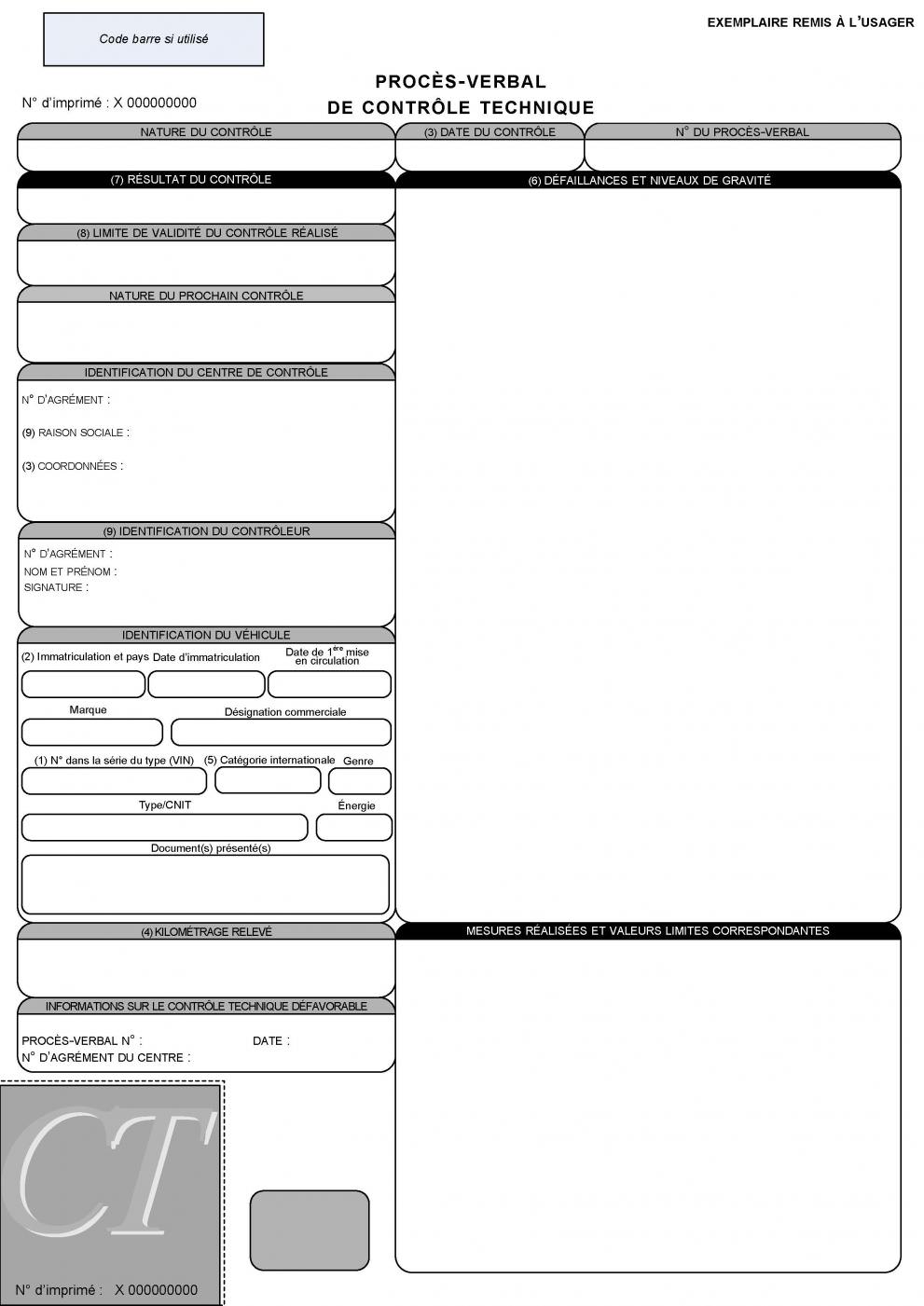
Fuente: Comisión Europea
► Frecuencia de inspección
Para la categoría M1, la primera prueba obligatoria se realiza dentro de los cuatro años siguientes a la fecha de entrada en servicio, y posteriormente cada dos años.
Certificado de Inspección Técnica en Alemania
Para importar vehículos a Alemania, tendrás que pasar la inspección técnica conocida popularmente como TÜV.
Esta inspección lleva el nombre de una de las organizaciones que realizan pruebas para obtener el permiso de circulación, el Technischer Überwachungsverein (TÜV).
► Modelo RWC alemán
Los certificados RWC/TÜV, como el que puedes encontrar a continuación, están impresos en papel azul A4.
Puedes comprobar la autenticidad del certificado buscando una marca de agua de seguridad con el logotipo de TÜV, y un sello redondo con el nombre de la organización y el número de identificación del inspector.
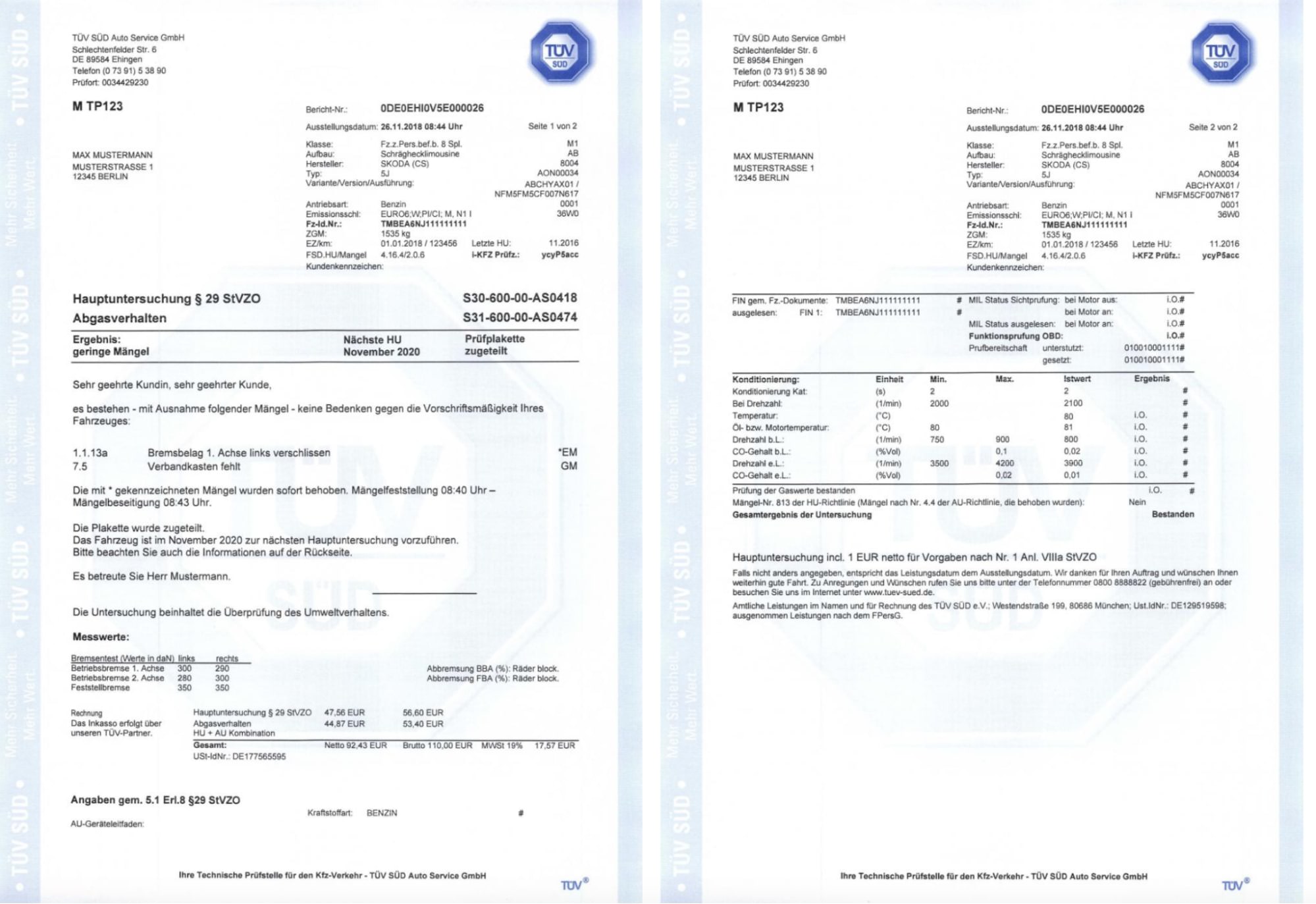 Fuente: Comisión Europea
Fuente: Comisión Europea
► Frecuencia de inspección
Para los vehículos M1, la primera inspección se realiza dentro de los tres años posteriores a la fecha de la primera matriculación, seguida de cada dos años.
Certificado de Inspección Técnica en España
Como ya mencionamos, la inspección técnica española necesaria para obtener la RWC se llama ITV (Inspección Técnica de Vehículos).
Pasar la ITV es uno de los pasos que debes seguir para importar un coche a España, por lo que es importante estar preparado para los requisitos y trámites que conlleva.
Puedes ver la localización de todos los centros de inspección homologados por la DGT en la página web de la DGT (Dirección General de Tráfico).
► Modelo RWC español
El RWC español es principalmente blanco y está impreso en papel A4. Ten en cuenta que el certificado puede verse ligeramente diferente entre las regiones españolas, ya que algunos certificados pueden tener logotipos específicos de la región, el centro de pruebas o la entidad de inspección.
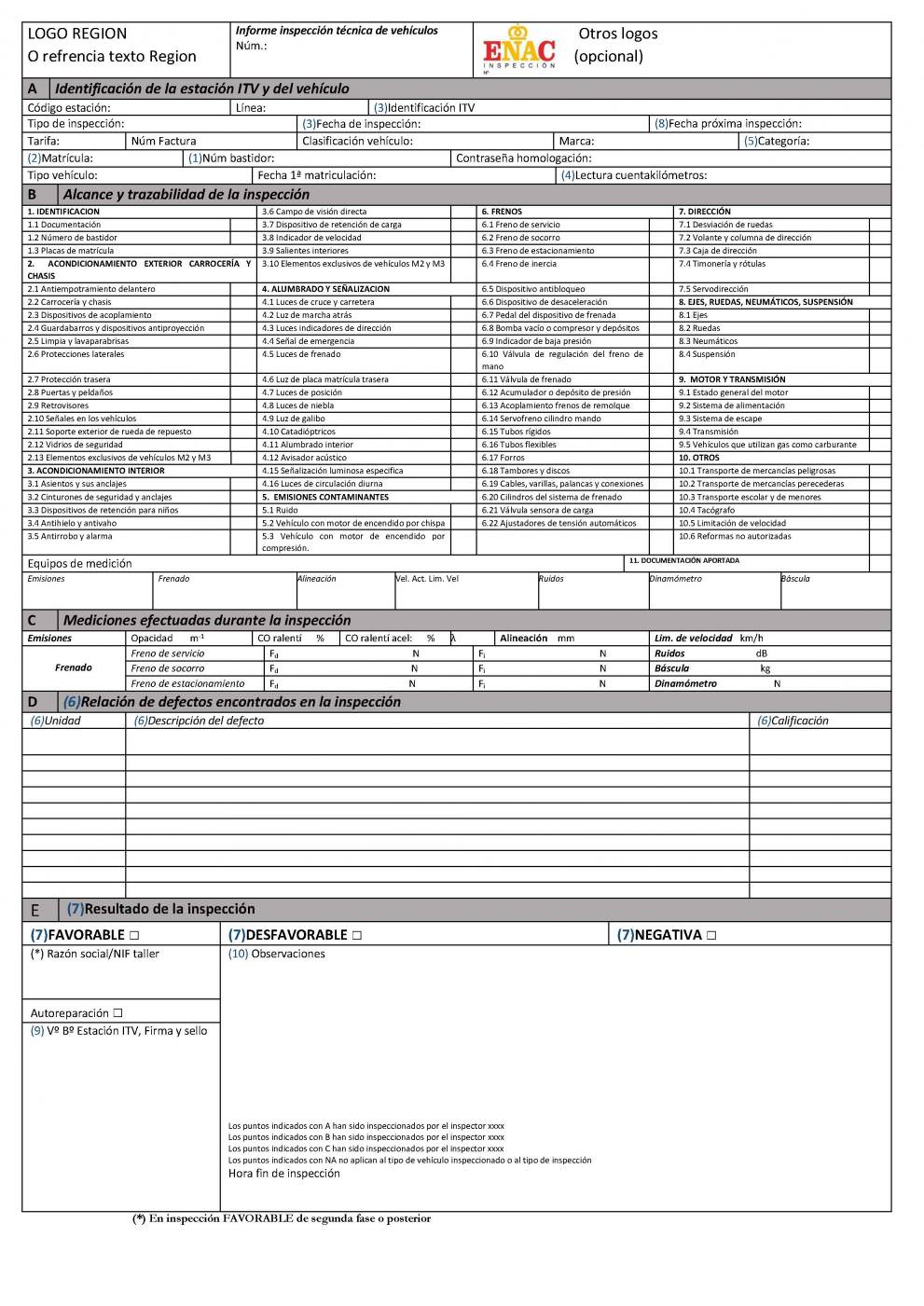
Fuente: Comisión Europea
► Frecuencia de inspección
En España, la primera inspección para turismos es obligatoria a los cuatro años. Las siguientes inspecciones se realizan cada dos años hasta que el vehículo cumpla diez años, después de lo cual hay que realizar inspecciones anuales.
Certificado de Inspección Técnica en Países Bajos
Para registrar un automóvil en los Países Bajos es necesario aprobar el Algemene Periodieke Keuring (APK), que es la versión holandesa del RWC.
La organización que supervisa las inspecciones de APK se llama Dienst Wegverkeer (comúnmente conocida como RDW, su nombre anterior). Por lo tanto, si tienes preguntas sobre los procedimientos del APK, es posible que ya estén respondidas en el sitio de RDW sobre inspecciones técnicas.
► Modelo RWC neerlandés
El certificado de inspección técnica de Países Bajos está impreso en papel A4 y suele ser blanco. ¡No te sorprenderá descubrir que el naranja es el color elegido para resaltar las secciones!
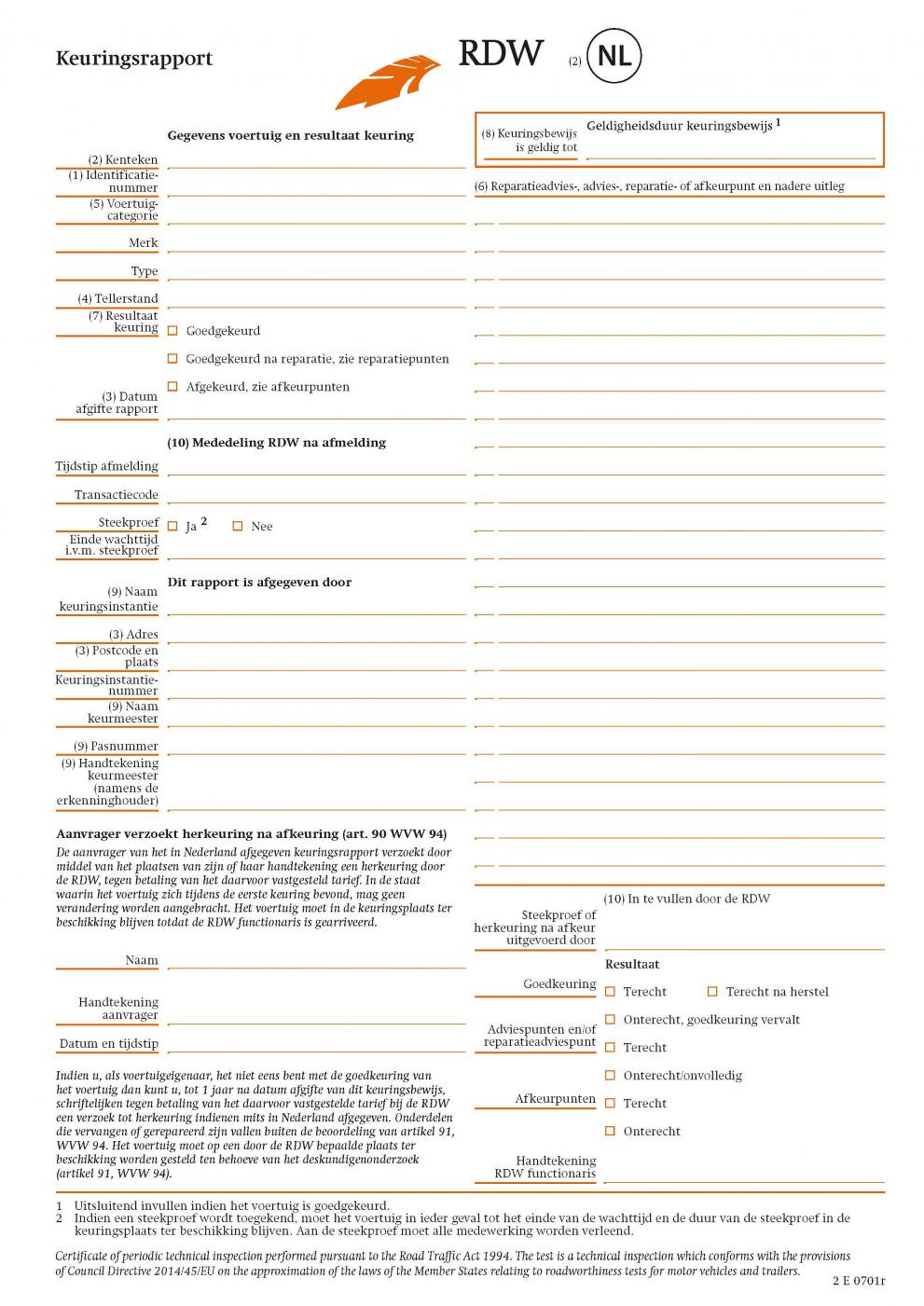
Fuente: Comisión Europea
► Frecuencia de inspección
El primer APK para vehículos M1 se requiere cuatro años después del registro inicial. Posteriormente, las inspecciones son cada dos años, y a partir de los ochos años anualmente.
Certificado de Inspección Técnica en Bélgica
Bélgica tiene dos nombres para su versión RWC: Contrôle technique y Autokeuring. Puedes encontrar una descripción general de la información sobre cómo obtener el certificado en el sitio web de GOCA.
► Modelo RWC belga
Bélgica tiene un sistema único para emitir RWC de vehículos M1, ya que puedes recibir certificados en dos colores diferentes.
Si obtienes un papel A4 verde, significa que el vehículo ha pasado la inspección sin deficiencias o sólo con problemas menores. Puedes ver un ejemplo a continuación.
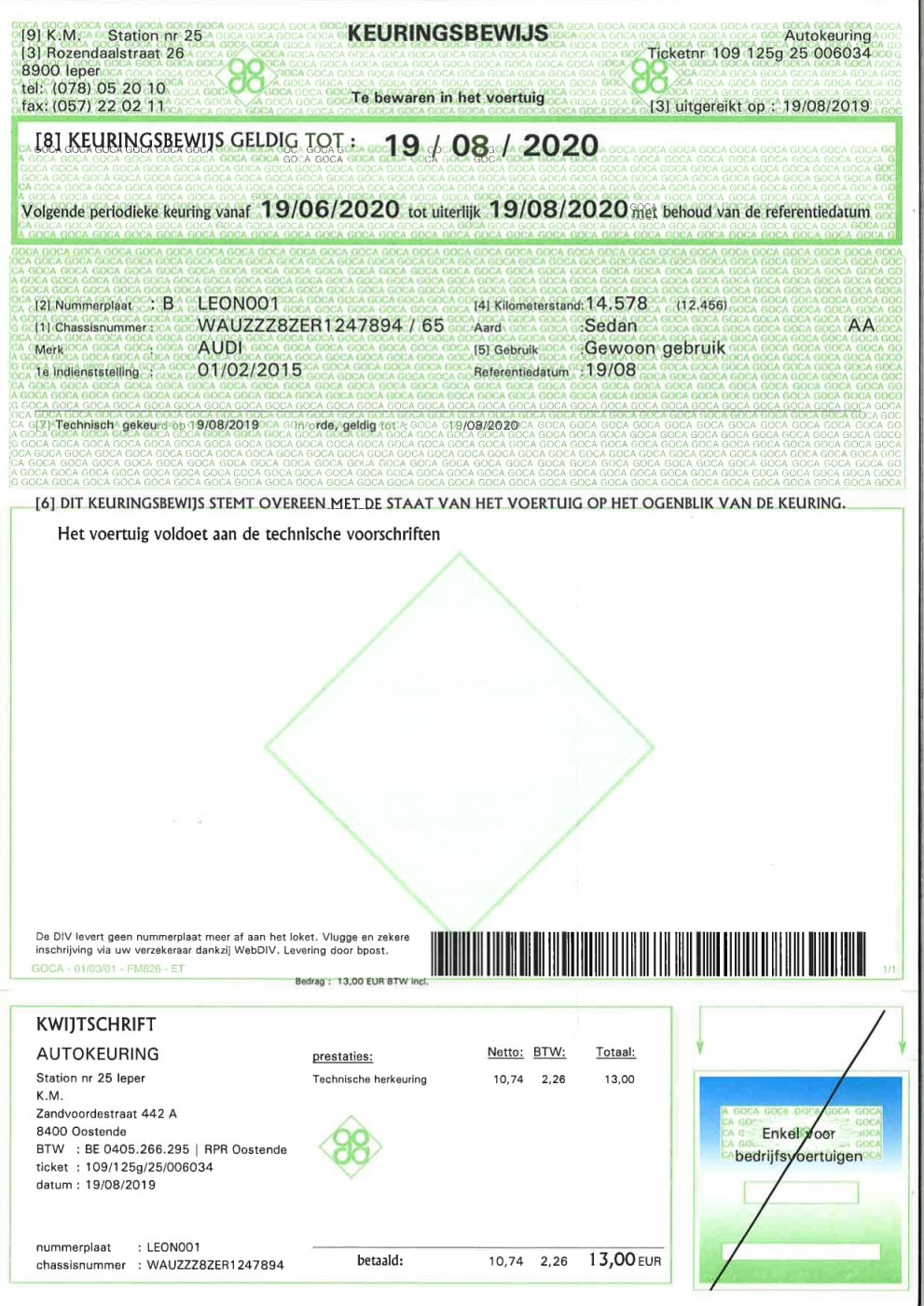
Fuente: Comisión Europea
Sin embargo, si recibes un documento rojo significa que hay problemas importantes que deben solucionarse en un plazo de 15 días.
Este certificado temporal te permite conducir el vehículo por un corto tiempo mientras realizas las reparaciones necesarias.
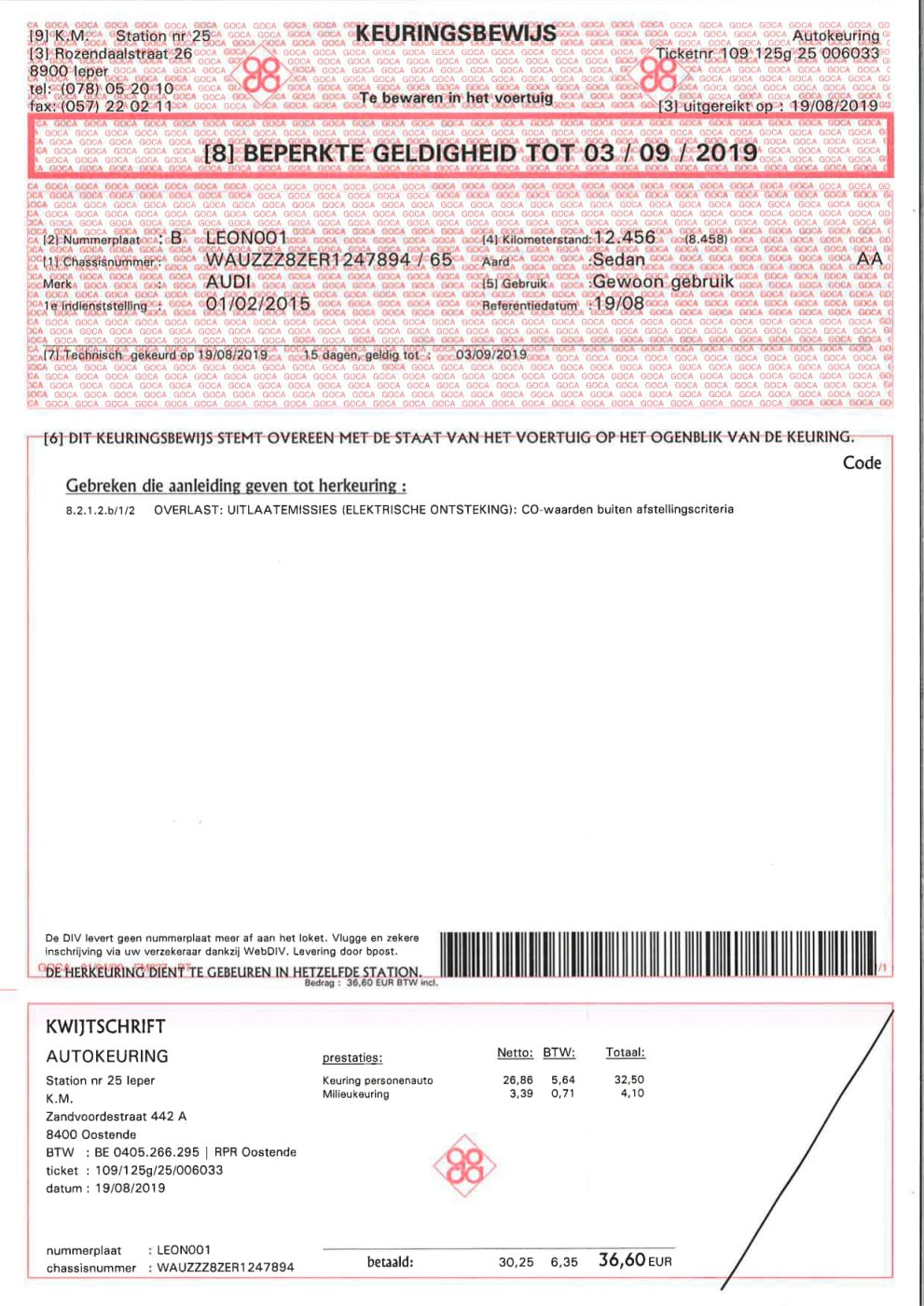
Fuente: Comisión Europea
► Frecuencia de inspección
Los vehículos M1 deben pasar su primera inspección antes de cumplir los cuatro años de registro. Después de eso, se requieren inspecciones anuales.
Certificado de Inspección Técnica en Portugal
En Portugal, el RWC tiene varios nombres:
- Inspeção Periódica Obrigatória
- Inspeção Técnica Periódica
- Inspeção Automóvel Obrigatória
Sin embargo, el nombre más utilizado es simplemente el acrónimo IPO.
Para obtener el certificado e importar un coche a Portugal, debes llevar tu vehículo a un centro de pruebas autorizado y regulado por el Instituto da Mobilidade e dos Transportes (IMT).
► Frecuencia de inspección
En Portugal, los vehículos necesitan una inspección IPO cuatro años después de su primera matriculación. Después de eso, se requieren inspecciones cada dos años hasta que el vehículo tenga ocho años, y luego anualmente.
Certificado de Inspección Técnica en Italia
El RWC en Italia se llama Revisione y lo emite la Motorizzazione Civile (Oficina de Licencias de Vehículos).
Lo necesitarás para importar un automóvil a Italia, así que es una buena idea consultar los detalles sobre Revisione en el sitio web del Ministerio de Infraestructura y Transporte.
► Modelo RWC italiano
El certificado RWC italiano es blanco con reflejos azules, y está impreso en papel A4.
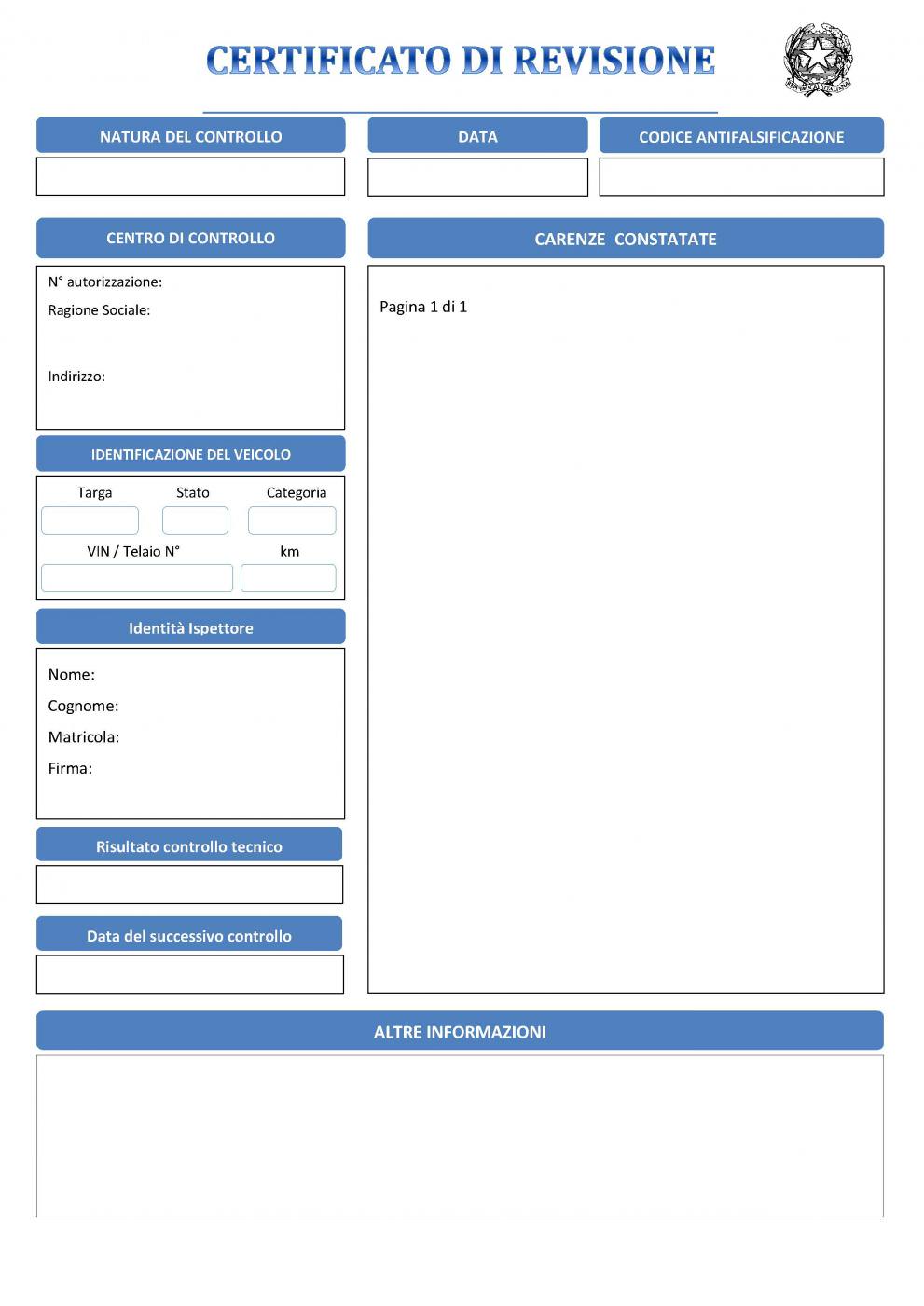
Fuente: Comisión Europea
► Frecuencia de inspección
Los vehículos M1 se inspeccionan cuatro años después de la primera matriculación y a continuación cada dos años.
Conclusión
Aquí lo tienes: ¡un resumen de los certificados de Inspección Técnica europeos!
Esperamos que este desglose te haya ayudado a comprender mejor los procesos de importación y registro de automóviles en varios países de la UE.
Conocer esta información esencial te ayudará a cumplir con las regulaciones, y te garantizará que tus vehículos sean seguros y fiables.
Por lo tanto, te animamos a cumplir con las normas para evitar posibles problemas legales y cuidar la reputación de tu concesionario de automóviles.

